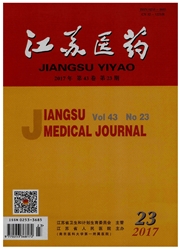

 中文摘要:
中文摘要:
目的探讨椎间植骨融合术和后外侧植骨融合术治疗腰椎退行性病变对腰椎后凸Cobb角的影响。方法47例腰椎退行性病变患者分为椎问融合植入Cage组(A组,36例)和后外侧植骨融合组(B组,11例)。在侧位X线片上,按病变节段分别计算两组术前和末次随访时的后凸Cobb角度及其差值。结果A、B两组患者末次随访时不同病变节段的Cobb角度均大于术前(Pd0.01);A组L4-L5和L5-s1的Cobb角度差值均大于B组[(3.86±2.11)度V8.(1.29±0.92)度和(3.72±2.08)度VS,.(O.73±o.22)度3(P<O.01)。结论椎间融合和椎体后外侧融合两种术式都能有效改善腰椎退行性病变时腰椎后凸Cobb角;椎问融合术式增大Cobb角和维持腰椎前凸的效果更好。
 英文摘要:
英文摘要:
Objective To investigate the effect of interbody fusion and posterolateral fusion of the vertebrae on Gobb's angle of kyphosis in the treatment of lumbar degenerative disease. Methods A total of 47 patients with lumbar degenerative disease was divided into two groups of A(operated by interbody fusion with cage, 36 cases) and B(operated by posterolateral fusion, 11 cases). Based on lateral X-ray films, the Cobb's angles of kyphosis before operation and at the final follow-up in both groups were measured in different diseased segments. Results Cobb's angles of different diseased segments at the final follow-up in both groups were larger than those before(P〈0. 01). The D-values of Cobb's angles of L, L5 and Ls-S1 in group A were larger than those in group B[(3. 86±2. 11) degrees vs. (1.29±0. 92) degrees and (3.72±2.08) degrees vs. (0. 73±0. 22) degrees] (P〈0. 01). Conclusion Both interbody fusion and posterolateral fusion can effectively enlarge the Cobb's angle of kyphosis in the patients with lumbar degenerative disease, in which interbody fusion is better than posterolateral vertebral fusion in enlarging Cobb's angle and maintainin~ lumbar lordosis.
 同期刊论文项目
同期刊论文项目
 同项目期刊论文
同项目期刊论文
 The release of glutamate from cortical neurons regulated by BDNF via the TrkB/Src/PLC-gamma 1 pathwa
The release of glutamate from cortical neurons regulated by BDNF via the TrkB/Src/PLC-gamma 1 pathwa ~G-protein-coupled receptor kinase interactor-1 serine 419 accelerates premature synapse formation i
~G-protein-coupled receptor kinase interactor-1 serine 419 accelerates premature synapse formation i 期刊信息
期刊信息
